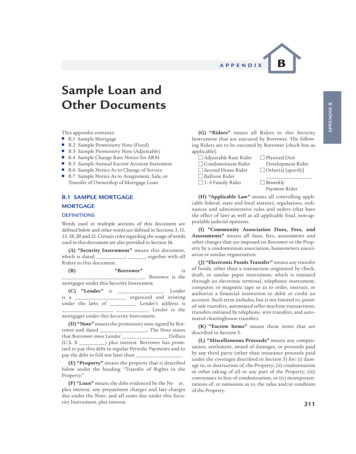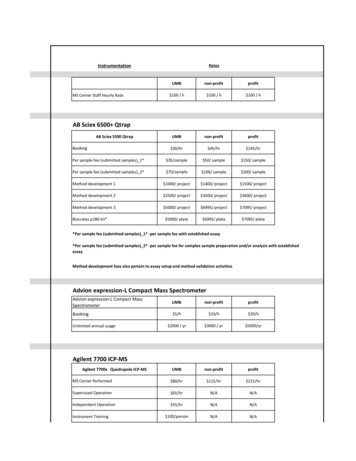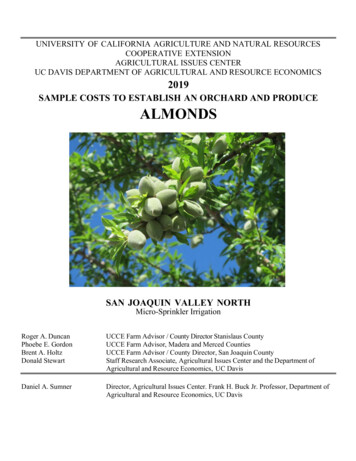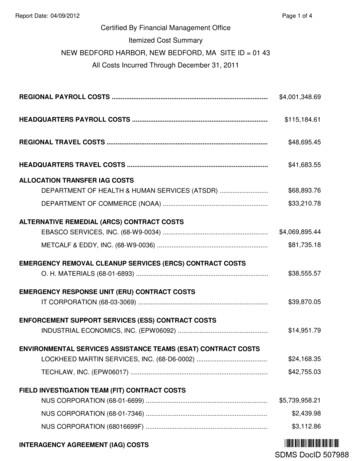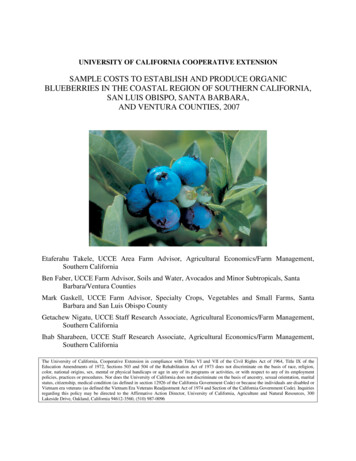
Transcription
UNIVERSITY OF CALIFORNIA COOPERATIVE EXTENSIONSAMPLE COSTS TO ESTABLISH AND PRODUCE ORGANICBLUEBERRIES IN THE COASTAL REGION OF SOUTHERN CALIFORNIA,SAN LUIS OBISPO, SANTA BARBARA,AND VENTURA COUNTIES, 2007Etaferahu Takele, UCCE Area Farm Advisor, Agricultural Economics/Farm Management,Southern CaliforniaBen Faber, UCCE Farm Advisor, Soils and Water, Avocados and Minor Subtropicals, SantaBarbara/Ventura CountiesMark Gaskell, UCCE Farm Advisor, Specialty Crops, Vegetables and Small Farms, SantaBarbara and San Luis Obispo CountyGetachew Nigatu, UCCE Staff Research Associate, Agricultural Economics/Farm Management,Southern CaliforniaIhab Sharabeen, UCCE Staff Research Associate, Agricultural Economics/Farm Management,Southern CaliforniaThe University of California, Cooperative Extension in compliance with Titles VI and VII of the Civil Rights Act of 1964, Title IX of theEducation Amendments of 1972, Sections 503 and 504 of the Rehabilitation Act of 1973 does not discriminate on the basis of race, religion,color, national origins, sex, mental or physical handicaps or age in any of its programs or activities, or with respect to any of its employmentpolicies, practices or procedures. Nor does the University of California does not discriminate on the basis of ancestry, sexual orientation, maritalstatus, citizenship, medical condition (as defined in section 12926 of the California Government Code) or because the individuals are disabled orVietnam era veterans (as defined the Vietnam Era Veterans Readjustment Act of 1974 and Section of the California Government Code). Inquiriesregarding this policy may be directed to the Affirmative Action Director, University of California, Agriculture and Natural Resources, 300Lakeside Drive, Oakland, California 94612-3560, (510) 987-0096
SAMPLE COSTS TO ESTABLISH AND PRODUCE ORGANIC BLUEBERRIES INTHE COASTAL REGION OF SOUTHERN CALIFORNIA, SAN LUIS OBISPO, SANTABARBARA, AND VENTURA COUNTIES, 2007Table of ContentsPage3INTRODUCTION3ASSUMPTIONS: CULTURAL PRACTICES AND COST CALCULATIONSFarm Size and Crop Characteristics4Land Preparation4Wood Waste and Compost zation6Irrigation7Pest Management7Pollination8Frost Protection8Harvesting and Marketing9Yield9Labor Costs9Equipment Operating Costs9Cash Overhead Costs10Non-Cash Overhead Costs11Crop Returns1213SUMMARY14PROFIT ANALYSIS15ACKNOWLEDGMENTSTABLES IN THE TEXTTable A.Table B.Table C.Table D.Table E.Fertilizer Application Rates in Organic Blueberry Production inSan Luis Obispo, Santa Barbara, and Ventura CountiesBird Control Materials and Installation Costs for Organic Blueberry Productionin San Luis Obispo, Santa Barbara, and Ventura Counties, 2007Estimated Annual Yield of Organic Blueberry Production inSan Luis Obispo, Santa Barbara, and Ventura CountiesLos Angeles Terminal Market Prices for Imported Blueberries (January-May,2005-2007), Percentage of Crop Harvested and Marketed, and WeightedAverage PriceEstimated Annual Yield and Gross Income of Organic Blueberry Production inSan Luis Obispo, Santa Barbara, and Ventura Counties, 2007UCCE, Sample Costs to Establish and Produce Organic Blueberries in San Luis Obispo, SantaBarbara, and Ventura Counties, 200768913131
FIGUREFigure 1. Proportion of Organic Blueberry Production Costs in San Luis Obispo, Santa Barbara,and Ventura Counties, 200714COSTS OF PRODUCTION AND RETURNS TABLESTable 1. Sample Costs per Acre to Establish Organic Blueberries inSan Luis Obispo, Santa Barbara, and Ventura Counties, 200716Table 2. Costs per Acre by Category to Produce Organic Blueberries inSan Luis Obispo, Santa Barbara, and Ventura Counties, 200717Table 3. Costs per Acre by Operation to Produce Organic Blueberries inSan Luis Obispo, Santa Barbara, and Ventura Counties, 200718Table 4. Costs and Returns per Acre to Produce Organic Blueberries inSan Luis Obispo, Santa Barbara, and Ventura Counties, 200719Table 5. Monthly Cash Costs per Acre to Produce Organic Blueberries inSan Luis Obispo, Santa Barbara, and Ventura Counties, 200720Table 6. Whole Farm Equipment, Investment, and Business Overhead Costs Basedon a-10 Acre Organic Blueberry Farm in San Luis Obispo, Santa Barbara, andVentura Counties, 200721Table 7. Hourly Equipment Costs to Produce Organic Blueberries inSan Luis Obispo Santa Barbara, and Ventura Counties, 200722Table 8. Range Analysis: Analysis of Costs and Returns for Producing OrganicBlueberries at Varying Yields and Prices in San Luis Obispo, Santa Barbara, andVentura Counties, 200723Table 9. Break-Even Prices ( Per Pound) of Organic Blueberry Production inSan Luis Obispo, Santa Barbara, and Ventura Counties, 200724Table 10. Break-Even Yields (Pounds Per Acre) of Organic Blueberry Production inSan Luis Obispo, Santa Barbara, and Ventura Counties, 200724REFERENCES25UCCE, Sample Costs to Establish and Produce Organic Blueberries in San Luis Obispo, SantaBarbara, and Ventura Counties, 20072
SAMPLE COSTS TO ESTABLISH AND PRODUCE ORGANIC BLUEBERRIES INTHE COASTAL REGION OF SOUTHERN CALIFORNIA, SAN LUIS OBISPO, SANTABARBARA, AND VENTURA COUNTIES, 2007INTRODUCTIONBlueberry production in the United States began with collection of wild berries growing in theEastern and Northeastern states. Then during the early to mid 1900s, cultivated blueberryproduction began with the breeding of northern highbush type blueberries, developed in thecooler regions of the United States including New Jersey, Massachusetts, Maine, Michigan andeventually moving west into Oregon, and Washington. In the mid 1970’s, a cooperative plantbreeding effort between the USDA and several universities in the southeastern US - including theUniversity of Florida - led to the release of the first low-chill requirement “southern” highbushblueberry for early season production in the southeast. In the late 1990s, efforts to growblueberries began in California based on these southern highbush types and blueberry plantingshave continued to expand since that time (Jimenez, et al, 2005). As of 2007, it is estimated thatover 4000 acres of blueberries are planted in California.Sample costs to establish and produce organic blueberries in the Coastal Region of southernCalifornia (CRSC) particularly in San Luis Obispo (SLO), Santa Barbara, and Ventura countiesare presented in this study. Operations described are based on production practices consideredtypical for the area and may not apply to every situation. The study is intended as a guide formaking production decisions, estimating potential returns, preparing budgets and evaluatingproduction loans. A blank “Your Costs” column in some of the cost tables is provided forentering and comparing individual farm costs with ours.The hypothetical farm operations (production practices) and cost calculations are described in theassumptions section. For additional information or explanations of the assumptions andcalculations used in this study, please contact Eta Takele, the Area Farm Management Advisor,or Ben Faber and Mark Gaskell, Farm Advisors in Ventura, Santa Barbara, and San Luis Obispocounties, respectively. This cost study can be accessed from the following websites: the FarmManagement Website of the University of California Cooperative Extension Program forSouthern California at: http://groups.ucanr.org/farmgt, the University of California Hansen Trustwebsite at: http://groups.ucanr.org/Hansen/index.cfmand the University of California,Department of Agricultural and Resource Economics websites at Davis at:http://coststudies.ucdavis.edu.ASSUMPTIONS: CULTURAL PRACTICES AND COST CALCULATIONSThe discussion in this section includes production practices (inputs, application rates and time ofapplication and methods). Input prices, contract fees and service expenses that are not mentionedin the text are included in Table 4. Prices and costs are for the year 2007.UCCE, Sample Costs to Establish and Produce Organic Blueberries in San Luis Obispo, SantaBarbara, and Ventura Counties, 20073
The use of trade names in this report does not constitute an endorsement orrecommendation by the University of California nor is any criticism implied by omission ofother similar products.Organic Certification: Production of organic crop requires special growing conditions. Growersmust follow the certified organic production requirements in compliance with the USDANational Organic Program (NOP). Check with an approved organic certifier to determine allcompliance related issues. All cultural practices mentioned in this document are intended tocomply with NOP certification guidelines.Farm Size and Crop Characteristics: This study is based on 10 acres of organic blueberryproduction.Blueberries are a perennial crop with a production life of over 20 years. In California, manycultivars are still under investigation for their adaptability and suitability to the region.Therefore, growers may be switching to a new cultivar even before the full productive life of theplanting is reached. In this study, we are assuming a 23 year life (i.e. three years of establishmentand 20 years production period). It should also be noted that the time of establishment may bevariable depending upon the size of the plant at planting, the suitability of the growing area to theblueberry plant and the effectiveness of the cultural practices.Land Preparation: Many blueberry plantings in the coastal southern California productionareas are established in what had been strawberry or vegetable production fields. However, forthis study, the blueberry planting is based on open or new land (not previously cultivated).Therefore operations and costs of land preparation, irrigation installations and/ or fertilitymanagement could be higher than previously cultivated land.Land preparation operations include first clearing off weeds, bushes, roots and plants followedby application of 5 tons per acre of compost and bed preparation. Growers usually use contractoperators to get land preparation done (Table 1). The field is then marked with flags where holesare dug for planting; an operation considered taking one minute per plant.Wood Waste and Compost Application: Compost at 5 tons per acre is applied as a preplantfertilizer. During establishment years, wood waste in the form of coarse, wood waste is appliedto promote growth of the young blueberry plants. On heavier, slow to drain soils, wood waste isincorporated into beds prior to planting. Application of wood waste may range from 4 to 6 inchesdeep and covers a 4 feet band centered on the plant row. The wood waste has to be replenishedregularly as it will deteriorate over time. Deteriorated wood waste adds organic matter to the soiland creates favorable environment for root growth, however, root damage can occur if it is notreplenished as needed. In this study, it is assumed that 50 tons of wood waste per acre will beapplied during the first year, and replenished with about 20 tons per acre every two years. Woodwaste costs around 10 per ton. In this study, we assume that the farmer needs around 5 manhours per acre for application of wood waste during the first year and 2 man-hours per acre everyUCCE, Sample Costs to Establish and Produce Organic Blueberries in San Luis Obispo, SantaBarbara, and Ventura Counties, 20074
two years. On very sandy soil, wood waste is applied on the surface. It does not need to beincorporated.Acidification: The blueberry plant is acid-loving with the optimum soil pH level in the 4.0 to 5.0range. It is important to analyze soil samples to determine the initial pH of the soil and the levelof sulfur needed for acidification. In the coastal California region, adjustments are usuallynecessary since most soils have pH levels between 6.7 and 8.0. Adjustments for organicblueberry production are made using organically certified pelletized sulfur application rangingfrom 3,000 pounds per acre to 7,000 pounds per acre. For this study, we used sulfur applicationat 5,000 pounds per acre before planting. Labor cost for sulfur application is estimated at 120per acre. Also, incorporation of sphagnum peat in the planting hole will also lower soil pH , thushelping adjust the acid environment for plant establishment.Soil pH monitoring is important. Soil pH above 5.0 will cause plants to grow very slowly andremain weak. Plants that grow on land with an improper pH may become yellow, grow poorlyand also may show a sign of iron deficiency or chlorosis and it should be corrected with an ironchelate application.Soil pH can be adjusted using citric or acetic acid (vinegar) in the irrigation water at a rate of 780pounds per acre per year. In this study, citric acid is assumed to be applied annually throughoutthe life of the crop. In addition, 200 pounds per acre per year sulfur will be applied.Organically certified iron chelate fertilizers may be applied as a drench, injected into theirrigation system or applied as a foliar spray. Iron helps plant growth even when the soil pH hasnot fallen to the optimum range of 4.5 to 5.0.Planting: Bushes used for planting may range from 12 to 18 months old. According to field trialresults, a number of Southern Highbush cultivars are well adapted to Southern California.Among them Emerald, Jewel, Star, Saphire, Sharpblue, and Misty are the most popular cultivarsin California. However, distribution of some patented blueberry cultivars may be limited tospecific nurseries; therefore availability may be an issue. Farmers must check with the blueberrynurseries for timing of plant availability before they plan plantings.Plant spacing may vary among growers. In this study, we assume plant spacings are 2.5 feetbetween plants within a row and 10 feet between rows allowing 1,750 plants per acre. The costof plants is approximated 3.50 each and planting in the coastal region can occur at any time. Forthis study, planting is in the month of June. Some of the bushes ( 2%) may not survive in thefirst year; and will be replanted in the second year.Most growers use contract or hired labor to perform the planting operation. At planting,sphagnum peat moss for lowering pH is incorporated into each hole at a rate of 1 bale for 40bushes. Incorporation of the peat moss and planting each is assumed to take one minute per bush.UCCE, Sample Costs to Establish and Produce Organic Blueberries in San Luis Obispo, SantaBarbara, and Ventura Counties, 20075
Pruning: Pruning is required to maintain the vigor and productivity of blueberry plants includingmaking the farm accessible for disease and insect inspection and management, as well asproviding easy access for harvest by removing low-fruiting branches or canes. For hand harvest,bushes are kept within easy picking height. Annual pruning is essential for consistent productionof high quality fruit.Pruning immediately after harvest has the advantage of allowing rapid shoot re-growth andflower bud initiation before the plant enters into the slow growth period of winter months.Studies have shown that pruning following transplanting stimulates new vegetative growth. Inthe first year, pruning involves primarily stripping off flowers and fruit. The cost of pruning inthe first year is estimated at 250 per acre. Beginning the second year, hand pruning is performedevery year and is estimated to take 0.5 minutes per plant.Fertilization: Table A provides the approximate amount of fertilizer requirement for organicblueberry production. Compost (5 tons/acre) is incorporated prior to planting and this will supplyapproximately 100 lb each of N, P, and K. Liquid fish fertilizer (Agrilizer 6-2-2 or similar) iscommonly applied in organic blueberry production as a source of nitrogen (N), phosphorus (P)and potassium (K). In the first year, N fertilizer application is from pre-plant compost.Beginning the second year, N application is mainly from Agrilizer or similar liquid fish fertilizer.In the second year application includes 10 pounds N per acre per month from December to Mayand 15 pounds N per acre per month from June to November. Beginning the third year, Napplication includes 15 pounds per acre from December to May and 30 pounds per acre permonth from June to November.Iron chelate application can be done either as a foliar spray or injected into the irrigation system.Iron chelate will relieve plants from iron deficiency related to soils with pH above 5.3. In thisanalysis, iron chelate is applied using the irrigation system; two times (June and July) for the firstyear and four times (April, May, June and July) per year from the second year on. Iron Chelate isapplied at the rate of 5 pounds per acre per time.Table A. Fertilizer Application Rates in Organic Blueberry Productionin San Luis Obispo, Santa Barbara, and Ventura CountiesYear123ProductionAmount ofCompostTons per Acre5Amount ofAgrilizerPounds per Acre250045004500Amount ofNitrogenPounds per Acre100150270270Amount ofIron ChelatePounds per Acre10202020Blueberry plants need a consistent soil moisture level for a fertilizer program to be effective. Theplants are shallow rooted therefore to ensure consistent soil moisture; frequent irrigation withsmall amounts of water must be applied.UCCE, Sample Costs to Establish and Produce Organic Blueberries in San Luis Obispo, SantaBarbara, and Ventura Counties, 20076
Soil and leaf analyses are done annually to determine the nutrient levels. Soil analysis must beginin the first year of planting while leaf analysis beings in the third year. N, Phosphorous (P),Potassium (K), Zinc (Zn) and Boron (B) levels will be analyzed from one sample. Soil and leaflaboratory analyses are approximated to cost 25 and 20 per acre per year, respectively.Irrigation water analysis should also be done periodically to determine the presence of nitrate,salinity, pH, chloride and sodium in well water.Irrigation: Growers in San Luis Obispo, Santa Barbara, and Ventura Counties use both districtwater and on-site wells for irrigation. Well water provides the majority of the growers’ needs inSan Luis Obispo and Santa Barbara Counties. District water may be delivered, stored andpumped from a reservoir through a filtration system. Water costs are calculated based upon theuse of both well and district sources. For this study, based on growers’ feedback, water cost isestimated at 22.10 per acre-inch.Water application is estimated at 24 acre-inches per acre per year during both the establishmentand the production period. Irrigation is applied weekly for about 44 weeks per year fromFebruary to November (except for the first year, the number of irrigation applications will be 26from planting in June to November). No assumption is made about effective rainfall,evaporation, or runoff. Information on evapotranspiration and rainfall if needed are availablefrom various sources including the Fox Canyon Groundwater Management Agency(http://www.foxcanyongma.org) and the California Irrigation Management Information System(CIMIS) at www.cimis.water.ca.gov/cimis.Labor to irrigate, and to monitor systems and check a field is estimated to take about 15 minutesper irrigation or 11 hours for the 44 annual irrigations.Pest Management: Blueberry growers should check their field continuously and control fungaland bacterial diseases as well as arthropods and vertebrates in order to ensure good productivity.Pest control in organic production is mainly done using cultural practices. For information andpesticide use permits, contact the local county agricultural commissioner's office or a PestControl Adviser (PCA). For information on cultural control of blueberry pests, consult theIntegrated Pest Management (IPM) guidelines that are applicable for cultural control of otherfruit crops or contact the local University of California Cooperative Extension Farm Advisors.Written recommendations made by licensed pest control advisors are required for use of manypesticides. PCAs can also be hired to monitor fields for pests and recommend nutrition.Following are descriptions of disease and pest control practices of in organic blueberryproduction.Weeds: Weed control begins in the second year and for organically produced blueberriesincludes mowing three times a year and hand weeding twice a year which takes approximately160 hours per acre per year.Diseases: Fruit and foliar diseases in organic blueberry production can be controlled throughselection of cultivars that are less susceptible and maintaining the farm with good culturalUCCE, Sample Costs to Establish and Produce Organic Blueberries in San Luis Obispo, SantaBarbara, and Ventura Counties, 20077
practices. Stem and root diseases are more difficult to control. Selection of disease free plantstocks, removing and discarding infected plant parts, raising beds with wood waste, and selectinga well drained ground will help to reduce the incident and severity of root and stem diseases.Fungal diseases: Fungal diseases in blueberry production in California include Botrytis blight(Botrytis cinerea) which affects the stem of the plant, as well as the fruit and the flower. Inorganic blueberry production, fungal diseases can be controlled with an annual application ofcopper at approximately 2 pounds per acre beginning in the second year. Phytophthora can be aproblem in poorly drained soils; which can be avoided with selection of site that is possibly freeof Phytophthora and with good land preparation.Bacterial disease: Canker (Pseudomonas spp.) is a common bacterial disease that affects thestem and leaf of the blueberry plant. Control for organically produced blueberries is usually onlythrough pruning out all affected parts of the plant.Bird control: One of the most important challenges of blueberry production is the control of fruitdamage by birds. Each year about 10 to nearly 100 percent of the blueberry crop can be lost tobird destruction. Netting is the only strategy that will completely reduce bird damage, though itis expensive and difficult to move around during cultural practices. In this study, it is assumedthat growers will install polyethylene netting material during the third year. In addition tonetting, at least one hour per week for five months (during harvesting) is needed for monitoringand maintaining the bird control system.Bird netting replacement may be necessary every five years. Table B presents the costbreakdown of the bird control system for blueberry production.Table B. Bird Control Materials and Installation Costs for Organic BlueberryProduction in San Luis Obispo, Santa Barbara, and Ventura Counties, 2007ItemsNetPostWireMaterials, Cement and OtherLabor for InstallationTotal Costs for One Acre ( )Total Costs for Ten Acre ( )Amount23000115500010UnitsfteachfthrPrice ( Per Unit)0.1100.113.3Total Cost ( )23001150500250133433343330Pollination: Cross pollination improves blueberry yield. Planting different cultivars in alternaterows can facilitate cross pollination. Planting the same cultivar within a row is, however,advantageous for ease of harvesting, so it is recommended not to mix varieties within the samerow. Two Beehives per acre will be placed in the field beginning the second year. A beehive canbe rented at approximately 125 a year.Frost Protection: Sprinkler irrigation is used for frost protection of fruits especially that areearly in the season from rare periods of frost damage along the Coast. This additional investmentUCCE, Sample Costs to Establish and Produce Organic Blueberries in San Luis Obispo, SantaBarbara, and Ventura Counties, 20078
is needed to protect early season fruits with high market prices. The system requiresapproximately 50 sprinkler heads, capable of delivering 3,000 gallons per hour per acre. Anautomatic temperature sensor and irrigation pump starter unit may also be needed or else manualovernight temperatures monitoring will be required. The estimated cost for frost protectionsystem with an automatic controller ranges from 1,500 – 2,000 per acre. In this study, the costof the frost protection is included in the irrigation system.Harvesting and Marketing: We assumed that the berry bushes at planting are already one yearold or more. Hence fruit bearing may start as early as 6 months after planting. Fruit is pickedinto buckets mostly using hired or contract labor. Some blueberry varieties begin to ripen bymid-December and usually finished by mid-June. Full ripening takes several days (3-5) after theyturn blue. In this study, we assume that 10% of the crop is harvested and marketed in January,15% in February, 20% in March, 40 % in April and 15% in May.Picking costs are estimated at 0.70 per pound and packing which includes pallet, clam shells,boxes is estimated at 1.50 per pound. Also 0.65 per pound is assumed for cooling, loading andquality control. Early season coastal blueberry growers typically move the fruit directly tomarket without additional storage fees. Marketing and brokerage fees are estimated at 0.75 perpound, (10% of blueberry prices).Yield: Yield estimates include 1 pound per bush in the second year, 4 pounds per bush in thethird and an average of 8 pounds per bush beginning the 4th year.Table C. Estimated Annual Yield of Organic Blueberry Production inSan Luis Obispo, Santa Barbara, and Ventura CountiesYear23ProductionNumber ofFruit BearingBushes Per Acre171517501750Average YieldPounds PerBush148Total YieldPounds PerAcre1715700014000Labor Costs: Wage rates for both the owner and hired labor are estimated at 13.15 per hour formachine operator and 11.80 per hour for non-machine labor. Labor wages include payroll taxes,workman compensation and other overhead costs associated with employment benefits.Equipment Operating Costs: Machinery repair costs are calculated using purchase prices,annual hours of use, total hours of life, and repair coefficients formulated by the AmericanSociety of Agricultural Engineers (ASAE). Fuel and lubrication costs are also determined byASAE equations based on maximum PTO horsepower and fuel type. According to the data fromthe USDA-NASS, prices for on-farm delivery of diesel and gasoline are 2.30 and 2.80 pergallon, respectively. The fuel, lube, and repair costs per acre for each operation are determinedby multiplying the equipment hourly operating cost by the number of hours per acre needed toUCCE, Sample Costs to Establish and Produce Organic Blueberries in San Luis Obispo, SantaBarbara, and Ventura Counties, 20079
perform the operation. Tractor and ATV time is 10% higher than implement time for a givenoperation to account for setup, travel and down time. Formulas for calculating equipmentoperating costs can be referenced from many farm management books including the one wefrequently use for our studies (Boelje, Michael D., and Vernon R. Eidman. 1984. FarmManagement, John Wiley and Sons. New York, New York).Cash Overhead Costs: Cash overhead costs consist of all cash expenses that are incurred in theblueberry farm but are not accounted for in the production practices. These costs include intereston operating capital, property taxes, office expenses, liability and property insurances, sanitationservices, equipment repairs, and management.Interest on Operating Capital: The cost of borrowing or the opportunity cost (interest onoperating capital) for money used in blueberry production is charged at 10% nominal interestrate on all operating expenses. Nominal interest rate is the current short term charge set byfinancial institutions for operating loans.Property Taxes: Real estate property taxes depend on the value of the property and local zoningordinances. We calculated property taxes at 1.0% (the rate most counties commonly charge) ofthe value (price) of land. For non-real estate properties, property taxes are estimated at 1.00%of the average values of the properties. Average values equal the price of the investment plussalvage value divided by two. Property taxes are then divided by the number of acres to obtainthe per acre costs.Property Insurance: Property loss coverage insurance is charged annually at 0.70% of theaverage value of the properties over their useful life. Property insurances are also divided bythe number of acres to obtain the per acre costs.Liability Insurance: Liability insurance costs to cover for accidents on the farm vary by size offarm. The cost of liability insurance for a 10 acre farm is approximately 437 per year ( 44 peracre per year).Field Sanitation: Regulations require one toilet and hand washing facility for each 20employees of each sex, located within a quarter mile walk, or if not feasible, at the closest pointof vehicular access. As an alternative to providing the required toilet and hand washingfacilities themselves, employers may transport employees conducting hand-labor operations totoilet and hand washing facilities (refer to specifications Cal/OSHA Field Sanitation Standard,Section 3457, Title 8, California Code of Regulations).For this study, one double mounted toilet facility is considered sufficient for the 10 acres foruse throughout the year. The rent for the facility is approximated at 270 per acre per year.Office Expense: Expenses for office rent, supplies, telephone, fax, internet, accounting, legalfees, utilities and miscellaneous administrative expenses are estimated at 350 per acre peryear.UCCE, Sample Costs to Establish and Produce Organic Blueberries in San Luis Obispo, SantaBarbara, and Ventura Counties, 200710
Investment Repair: Annual repair and maintenance costs for farm buildings, tools and reservoirare calculated at 2% of the price (value) of the investment. For irrigation system and birdcontrol, annual maintenance and repair costs are calculated at 5% of the cost of the system.Management/Supervisor Salaries: Management charges are not included in this study. Wesuggest that growers divide the returns after all costs between management and profit as theysee fit.Organic Certification Charges: California Certified Organic Farmers (CCOF) certificationcharges of 825, 1
Table 6. Whole Farm Equipment, Investment, and Business Overhead Costs Based on a-10 Acre Organic Blueberry Farm in San Luis Obispo, Santa Barbara, and Ventura Counties, 2007 21 Table 7. Hourly Equipment Costs to Produce Organic Blueberries in San Luis Obispo Santa Barbara, and Ventura Counties, 2007 22 Table 8.

